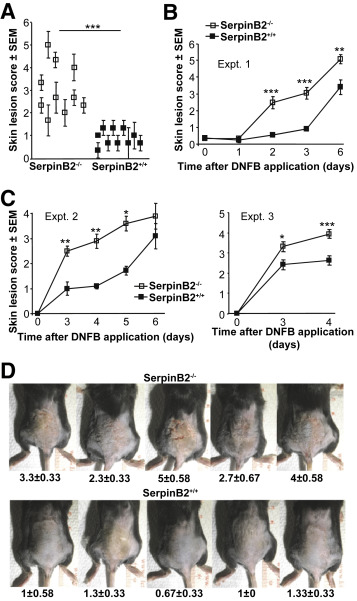SerpinB2 Deficiency Results in a Stratum Corneum Defect and Increased Sensitivity to Topically Applied Inflammatory Agents.
SerpinB2 (plasminogen activator inhibitor type 2) is constitutively expressed at high levels by differentiating keratinocytes in mice and humans; however, the physiological function of keratinocyte SerpinB2 remains unclear. Herein, we show that SerpinB2(-/-) mice are more susceptible to contact dermatitis after topical application of dinitrofluorobenzene, and show enhanced inflammatory lesions after topical applications of phorbol ester. Untreated SerpinB2(-/-) mice showed no overt changes in epithelial structure, and we were unable to find evidence for a role for keratinocyte SerpinB2 in regulating immunity, apoptosis, IL-1β production, proteasomal activity, or wound healing. Instead, the phenotype was associated with impaired skin barrier function and a defective stratum corneum, with SerpinB2(-/-) mice showing increased transepidermal water loss, increased overt loss of stratum corneum in inflammatory lesions, and impaired stratum corneum thickening after phorbol ester treatment. Immunoblotting suggested that SerpinB2 (cross-linked into the cornified envelope) is present in the stratum corneum and retains the ability to form covalent inhibitory complexes with urokinase. Data suggest that the function of keratinocyte SerpinB2 is protection of the stratum corneum from proteolysis via inhibition of urokinase, thereby maintaining the integrity and barrier function of the stratum corneum, particularly during times of skin inflammation. Implications for studies involving genetically modified mice treated with topical agents and human dermatological conditions, such as contact dermatitis, are discussed.
Authors
Wayne A Schroder; Itaru Anraku; Thuy T Le; Thiago D C Hirata; Helder I Nakaya; Lee Major; Jonathan J Ellis; Andreas Suhrbier
External link
Publication Year
Publication Journal
Associeted Project
Microbiology or Immunology
Lista de serviços
-
Gene regulatory and signaling networks exhibit distinct topological distributions of motifs.Gene regulatory and signaling networks exhibit distinct topological distributions of motifs.
-
Gene signatures of autopsy lungs from obese patients with COVID-19.Gene signatures of autopsy lungs from obese patients with COVID-19.
-
Network Medicine: Methods and ApplicationsNetwork Medicine: Methods and Applications
-
ACE2 Expression Is Increased in the Lungs of Patients With Comorbidities Associated With Severe COVID-19.ACE2 Expression Is Increased in the Lungs of Patients With Comorbidities Associated With Severe COVID-19.
-
Drug repositioning for psychiatric and neurological disorders through a network medicine approach.Drug repositioning for psychiatric and neurological disorders through a network medicine approach.
-
Linking proteomic alterations in schizophrenia hippocampus to NMDAr hypofunction in human neurons and oligodendrocytes.Linking proteomic alterations in schizophrenia hippocampus to NMDAr hypofunction in human neurons and oligodendrocytes.
-
In-depth analysis of laboratory parameters reveals the interplay between sex, age, and systemic inflammation in individuals with COVID-19.In-depth analysis of laboratory parameters reveals the interplay between sex, age, and systemic inflammation in individuals with COVID-19.
-
The evolution of knowledge on genes associated with human diseasesThe evolution of knowledge on genes associated with human diseases
-
Network vaccinology.Network vaccinology.
-
Pyruvate kinase M2 mediates IL-17 signaling in keratinocytes driving psoriatic skin inflammationPyruvate kinase M2 mediates IL-17 signaling in keratinocytes driving psoriatic skin inflammation
-
Transcriptome analysis of six tissues obtained post-mortem from sepsis patientsTranscriptome analysis of six tissues obtained post-mortem from sepsis patients
-
Gene Signatures of Symptomatic and Asymptomatic Clinical-Immunological Profiles of Human Infection by Leishmania (L.) chagasi in Amazonian BrazilGene Signatures of Symptomatic and Asymptomatic Clinical-Immunological Profiles of Human Infection by Leishmania (L.) chagasi in Amazonian Brazil
-
In vitro morphological profiling of T cells predicts clinical response to natalizumab therapy in patients with multiple sclerosis.In vitro morphological profiling of T cells predicts clinical response to natalizumab therapy in patients with multiple sclerosis.
-
Integrative immunology identified interferome signatures in uveitis and systemic disease-associated uveitis.Integrative immunology identified interferome signatures in uveitis and systemic disease-associated uveitis.
-
Gene regulatory networks analysis for the discovery of prognostic genes in gliomas.Gene regulatory networks analysis for the discovery of prognostic genes in gliomas.
-
Revealing shared molecular drivers of brain metastases from distinct primary tumors.Revealing shared molecular drivers of brain metastases from distinct primary tumors.

